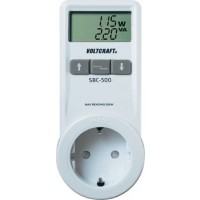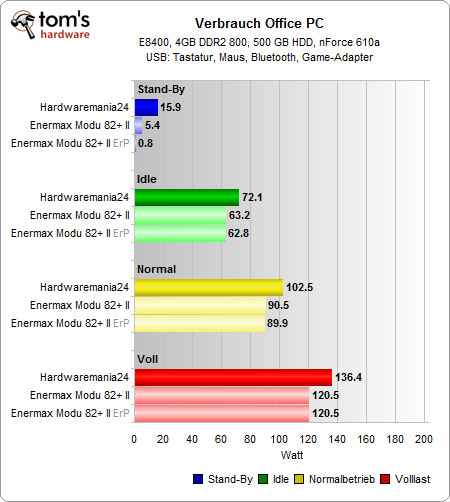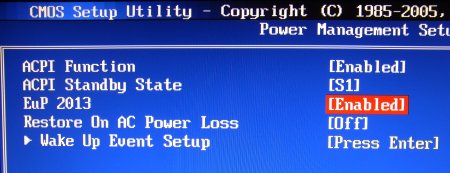The thrifty and the stingy Joe: two Enermax brothers mix stand-by-city
 The performance was unspectacular but forward-looking. We remember: ErP (lot 6) of the energy-saving straightlines, requires a maximum stand-by consumption of less than 1 watt. And so the stingy Joe gets the ErP-mark of quality overnight as a modified successor, while his thrifty brother, who had already opened his camp in the archive for some time, looks enviously into the evening sun of the energy-saving lamp. We are talking about the Modu 82+ II series from Enermax, which has now been adjusted to the level of requirements for 2010 in order to enforce the guidelines. The beauty of the whole action: we tested two actually identical power supplies and extracted the only difference in measurable numbers: the reduced stand-by consumption.
The performance was unspectacular but forward-looking. We remember: ErP (lot 6) of the energy-saving straightlines, requires a maximum stand-by consumption of less than 1 watt. And so the stingy Joe gets the ErP-mark of quality overnight as a modified successor, while his thrifty brother, who had already opened his camp in the archive for some time, looks enviously into the evening sun of the energy-saving lamp. We are talking about the Modu 82+ II series from Enermax, which has now been adjusted to the level of requirements for 2010 in order to enforce the guidelines. The beauty of the whole action: we tested two actually identical power supplies and extracted the only difference in measurable numbers: the reduced stand-by consumption.

The stingy Joe (left) and the thrifty Joe (right)
Enermax, along with a number of other power supply providers, is one of the protagonists of the rapid implementation of the energy saving guidelines. Even if the purchase price is higher than the simple budget device – the documentation and availability of clear information was and is exemplary. Quality has its price, which we also like to pay in terms of transparency and product labelling – of course only as long as the bottom line also pays off.
The brothers meet the common current – the showdown
Let’s look at the following diagrams, which actually speak for themselves without comment:
 We measured the data and consumption with the Voltcraft SBC-500 from Conrad Electronic. This amazingly inexpensive device has been specially developed for detecting stand-by losses and measures the actual consumption even in the milliwatt range sufficiently accurately. This as a tip to all those who are still looking for a sniffer dog for the electric penny graves, which in turn must not be more expensive than 25 euros.
We measured the data and consumption with the Voltcraft SBC-500 from Conrad Electronic. This amazingly inexpensive device has been specially developed for detecting stand-by losses and measures the actual consumption even in the milliwatt range sufficiently accurately. This as a tip to all those who are still looking for a sniffer dog for the electric penny graves, which in turn must not be more expensive than 25 euros.
Let’s look again:
Hardwaremania:
• 14 hours stand-by * 16 watts = 224 Wh
• 2 hours idle operation * 72.1 = 144.2 Wh
• 5 hours normal operation * 102.5 = 512.5 Wh
• 3 hours load operation * 136.4 = 409.2 Wh
Total: 1.29 kWh/day * 365 days * 0.22 Ct = 103.59 Euro
Enermax Modu82+ II:
• 14 hour stand-by * 5.4 watts = 75.6 Wh
• 2 hours idle operation * 63.2 = 126.4 Wh
• 5 hours normal operation * 90.5 = 452.5 Wh
• 3 hours load operation * 120.5 = 361.5 Wh
Total: 1.02 kWh/day * 365 days * 0.22 Ct = 81.91 Euro
Enermax Modu82+ II ErP:
• 14 hour stand-by * 0.8 watts = 11.2 Wh
• 2 hours idle operation * 62.8 = 125.6 Wh
• 5 hours normal operation * 89.9 = 449.5 Wh
• 3 hours load operation * 120.5 = 361.5 Wh
Total: 0.95 kWh/day * 365 days * 0.22 Ct = 76.29 Euro
If you calculate the difference, you save approx. per year with the ErP device compared to the low-cost power supply. 27.30 Euros, in 5 years there will be a substantial sum of 136.50 Euros. Far more than a reasonable power supply for this performance class would ever have cost. If this inferior part survives for so long. The comparison of the two Joes is not without its: 28 Euros lie between the brothers. Also more than the difference in purchasing.
Power supply + motherboard = ErP system
Of course, a power supply with “ErP ready” imprint alone is not enough, because it will always deliver what the motherboard demands. Only an ErP-compliant motherboard can be assembled into an ErP-compliant system together with the appropriate power supply. Conversely, a suitable motherboard is on ice if the power supply does not play along. In the case of off-mode, the computer can only be switched on via the power button, as all USB and PS2 ports are power-free, as well as the WOL function (Wake-On-Lan) has been deactivated. In addition, according to the Intel specification, the power supply should have an efficiency of over 50% in the 5-volt range up to 100 mA, so that less than 1 watt is sucked out of the grid at 500 mW of recalled power.
Evil Trap: Boards with disabled default settings
Not every motherboard provides the default activation of this power saving function in the default settings. Here are two examples from a BIOS of what that function might look like. Of course, the manual also helps in case of doubt.
- 1 - Einführung
- 2 - CE-Zeichenschwindel mit China-Export
- 3 - Praxistest: Katastrophe Office-PC
- 4 - Praxistest: einmal mit und einmal ohne ErP
- 5 - Online-Shops im Test:
- 6 - VV-Computer: Bei Mail Anruf samt Theorie
- 7 - Planet4One: die Pauschal-Kompatiblen
- 8 - CSV-Computer: das gibts doch (gar) nicht
- 9 - NorskIT: Wir sind billig, also nicht willig.
- 10 - Hardwareversand: Wissen ja, aber...
- 11 - Alternate: Kundenkonto statt Auskunft
- 12 - Mindfactory: Schraps hat den Hut verloren
- 13 - PCAnymore: Chef antwortet selbst
- 14 - Atelco: Seltsames Gleichnis und 80+ = Erp?
- 15 - Aussitzer: diese Shops schweigen komplett
- 16 - Mit
- 17 - Fazit: Hersteller Top, Handel Flop und ein Ratschlag von



































14 Antworten
Kommentar
Lade neue Kommentare
Urgestein
Urgestein
Veteran
Urgestein
Urgestein
Urgestein
Urgestein
Mitglied
Urgestein
Urgestein
Neuling
Urgestein
Neuling
Urgestein
Alle Kommentare lesen unter igor´sLAB Community →